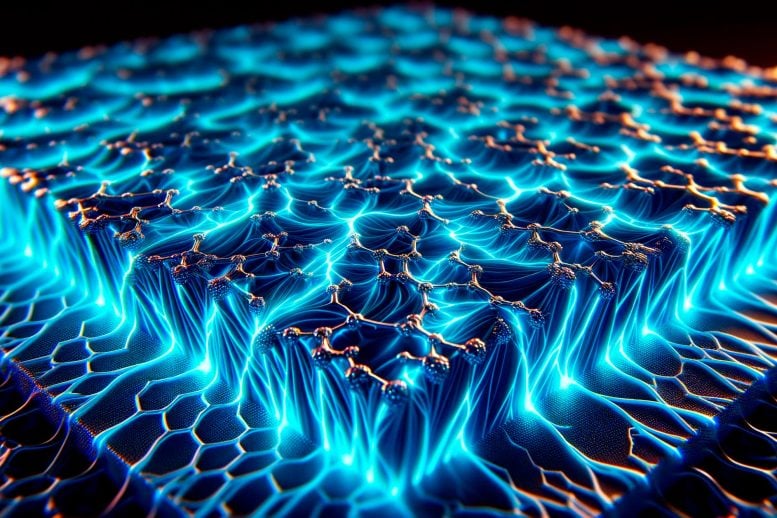go through
Researchers have used a new 2D/3D/2D heterostructure to produce a ferroelectric capacitor with 19 times the energy density of current models and an efficiency of over 90%. Image source: SciTechDaily.com
Scientists have developed a new method to use two-dimensional materials to control the relaxation time of ferroelectric capacitors, significantly enhancing their energy storage capabilities. This innovation brings a structure that increases energy density and efficiency, promising advances in high-power electronics and sustainable technologies.
Electrostatic capacitors play a vital role in modern electronics. They enable ultra-fast charging and discharging, providing energy storage and power for devices such as smartphones, laptops, routers, medical devices, automotive electronics and industrial equipment. However, ferroelectric materials used in capacitors have significant energy losses due to their material properties, making it difficult to provide high energy storage capabilities.
Innovations in Ferroelectric Capacitors
Sang-Hoon Bae, assistant professor of mechanical engineering and materials science at Washington University in St. Louis’ McKelvey School of Engineering, addressed the long-standing challenge of deploying ferroelectric materials in energy storage applications.
A study published today (April 18) in the journal scienceBae and his collaborators include Rohan Mishra, associate professor of mechanical engineering and materials science at UW; Chuan Wang, associate professor of electrical and systems engineering; and Frances Ross, TDK professor of materials science and engineering at UW. MITintroduces a method to control the relaxation time (an internal material property that describes the time it takes for a charge to dissipate, or decay) in ferroelectric capacitors using 2D materials.
Developing new heterostructures
Doctoral student Justin S. Kim and postdoctoral researcher Sangmoon Han collaborated with Bae to develop novel 2D/3D/2D heterostructures that minimize energy loss while retaining the beneficial material properties of ferroelectric 3D materials.
Their method cleverly sandwiched 2D and 3D materials in atomically thin layers, with carefully designed chemical and non-chemical bonds between each layer. A very thin 3D core is inserted between two outer 2D layers, creating a stack that is only about 30 nanometers thick.This is about one-tenth of the average Virus particle.
Breakthroughs in energy storage
“We created a new structure based on innovations in our lab involving 2D materials,” Bae said. “Initially, we were not focused on energy storage, but in the process of exploring the properties of the material, we discovered a new physical phenomenon that we realized could be applied to energy storage, which is very interesting and potentially more useful.”
2D/3D/2D heterostructures are engineered to sit at the sweet spot between conductivity and non-conductivity, where semiconductor materials have optimal electrical properties for energy storage. With this design, Bae and his collaborators report an energy density 19 times higher than commercially available ferroelectric capacitors and an unprecedented efficiency of over 90%.
Impact on next generation electronic products
“We found that very small gaps in the material’s structure can modulate or induce the dielectric relaxation time,” Bae explains. “This new physical phenomenon is something we have never seen before. It allows us to manipulate dielectric materials in a way that they do not polarize and lose their ability to charge.
As the world grapples with the urgent need to transition to next-generation electronic components, Bae’s new heterostructure materials paves the way for high-performance electronic devices, including high-power electronics, high-frequency wireless communications systems, and integrated circuit chips. These advances are particularly important for industries that require robust power management solutions, such as electric vehicles and infrastructure development.
Future directions and applications
“Fundamentally, the structure we developed is a new type of electronic material,” Bae said. “We’re not 100% optimal yet, but we’ve surpassed other labs’ performance. Our next step will be to make the structure of this material better so that we can meet the requirements of ultra-fast charging and discharging of capacitors and very High energy density is required. We must be able to do this without losing storage capacity due to repeated charging to see this material widely used in large electronics such as electric vehicles and other developing green technologies.
Reference: “Achieving high energy density in artificial heterostructures through relaxation time modulation,” April 18, 2024 science.
DOI: 10.1126/science.adl2835
Han S, Kim JS, Park E, Meng Y, Xu Z, Foucher AC, Jung GY, Roh I, Lee S, Kim SO, Moon JY, Kim SI, Bae S, Zhang X, Park BI, Seo S, Li Y , Shin H, Reidy K, Hoang AT, Sundaram S, Vuong P, Kim C, Zhao J, Hwang J, Wang C, Choi H, Kim DH, Kwon J, Park JH, Ougazzaden A, Lee JH, Ahn JH, Kim J, Mishra R, Kim HS, Ross FM and Bae SH. Achieve high energy density of artificial heterostructures through relaxation time modulation. scienceApril 18, 2024.
This work was supported by the U.S. National Science Foundation (2240995, DMR-2122070, and DMR-2145797), Samsung Electronics Co., Ltd. (IO221219-04250-01), Korea Institute of Technology Advancement (P0017305), National Research Institute of Korea Fund (2015R1A3A2066337) and the Army Research Office’s Multidisciplinary University Research Program (W911NF-21-1-0327). This work was accomplished by allocating DMR160007 computing resources from the Advanced Network Infrastructure Coordination Ecosystem: Services and Support (ACCESS) program, which is supported by NSF.
#material #increases #electrostatic #energy #storage #energy #density #times
Image Source : scitechdaily.com
